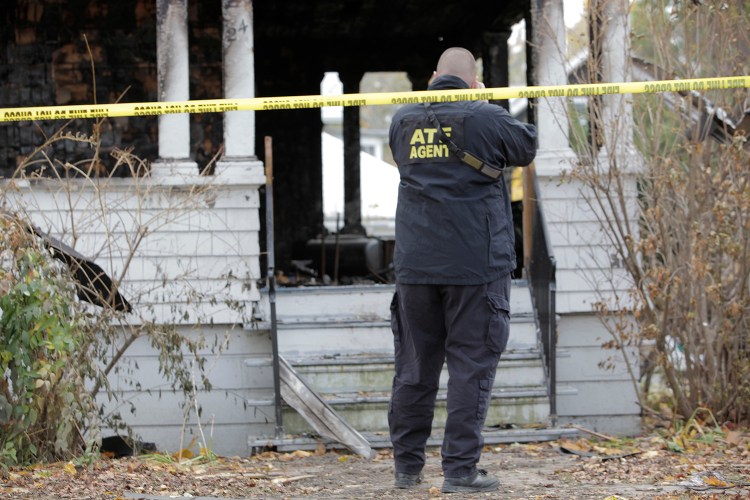Questions about the cause of Saturday’s fatal fire at 20 Noyes St. may go unanswered for days or even weeks, in part because of the extent of the damage and where the fire appears to have started, fire officials say.
Investigators also are compelled to conduct an exhaustive investigation – interviewing friends and acquaintances of everyone in the building, as well as survivors and witnesses – because of the number of fatalities.
Five people died in the fire, three of them residents. A sixth person – a visitor who was badly burned – died at a Boston hospital Tuesday. Saturday’s fire was the deadliest in Portland since six children were killed in a fire on Gilman Place in 1963.
Two residents escaped out a window as fire consumed half of the duplex at the corner of Noyes and Freeman streets. Everyone in the adjoining unit at 24 Noyes St. got out safely.
A vigil for the victims will be held Tuesday from 6 p.m. to 7 p.m. at Longfellow Park in Portland.
“Given the loss of life, you want to be as exacting as you can,” State Fire Marshal Joe Thomas said. “In that respect, you look at additional things like fire modeling and reverse engineering and other things that you might not do with a building fire where you didn’t have anything significant to add to the tragedy of it.”
Fire modeling and reverse engineering are techniques that might be employed by the Bureau of Alcohol, Tobacco, Firearms and Explosives, which has joined the investigation.
Modeling assesses how a fire behaved by re-creating the structure and conditions at the time it started. Reverse engineering entails taking extensive measurements of the materials, burn patterns, depth of char and other information and running it through a computer program that can calculate when it might have started and how it burned over time.
In the case of a dorm fire at the University of Southern Maine in 2012, investigators determined almost immediately that it was arson. The ATF used fire modeling to build a case against the person who was charged, four months later, with setting the fire.
The State Fire Marshal’s Office, which is the lead agency in the Noyes Street fire investigation, released no new information about the case Wednesday. But in an interview Tuesday, Thomas explained that determining a cause takes longer for some fires than for others.
“It’s really based on the kind of materials that we’re dealing with that appear to be around the area of origin,” he said.
In a fire that killed two people on Sept. 18 at 35 Main St. in Biddeford, investigators concluded it was arson within hours.
That fire started in an interior stairwell and there were no possible accidental sources, such as old wiring or discarded cigarettes, that could have caused it. There was also far less damage to the 14-unit building than there was at 20 Noyes St.
Investigators have employed the same techniques to locate the points of origin for both fires.
But the one at Noyes Street is more complex.
When firefighters arrived at Noyes Street, the fire already was raging, with the side porch and the area above it fully engulfed in flames.
“If you come to an area, for example, like the outside porch area of origin, it not only had certain combustible materials as a source, but other factors – environment, wind – could somewhat skew the picture,” he said.
Kyle Bozeman, who survived the fire, noted some blackened springs – all that remained of an old couch that had been on the porch. He said it would be a logical place for the fire to have started. Most of the residents in the house smoked – often on the porch – although he did not see anyone on the porch as late as 3 a.m. Saturday, he said.
Careless smoking is the leading cause of residential fire deaths in the United States, according to the National Fire Protection Association, which provides training for first responders. And three in five fire deaths occur in homes with no working smoke detectors.
A survivor said he didn’t hear any smoke detectors during the fires, but there has been no official word on whether there were working detectors in the building.
One of the mysteries surrounding Saturday’s fire is how it grew so quickly without anyone knowing it. The first calls were received by the Portland Fire Department at 7:17 a.m. When the first engine reported arriving at the scene at 7:22 a.m., the fire was already burning so hot that a crew trying to enter through the rear entrance was forced back, officials said.
Fires also can smolder for hours, then suddenly flare intensely.
“It can smolder up to a point where it generates enough smoke that it starts to starve itself for oxygen, and then enter a source of oxygen into that and you can look at smoke explosions” – the sudden massive and expansion of a fire, Thomas said. Even without a sudden oxygen source, combustible materials give off flammable gases as they are heated – these can accumulate and burst into flames when they become hot enough.
––––––––––––––––––
CORRECTION: This story was updated at 3:41 p.m. on Nov. 13 to correct the location of the 1963 fire in Portland.
Send questions/comments to the editors.


